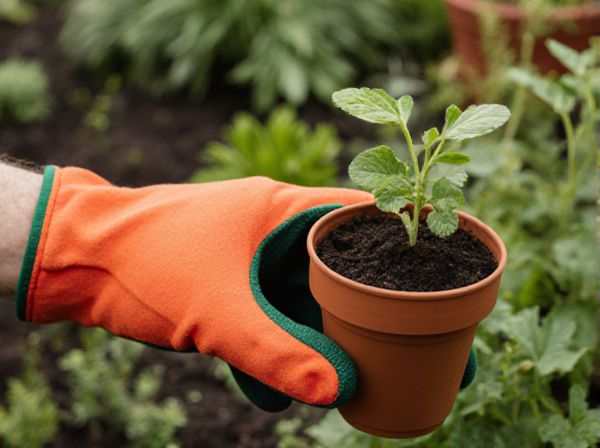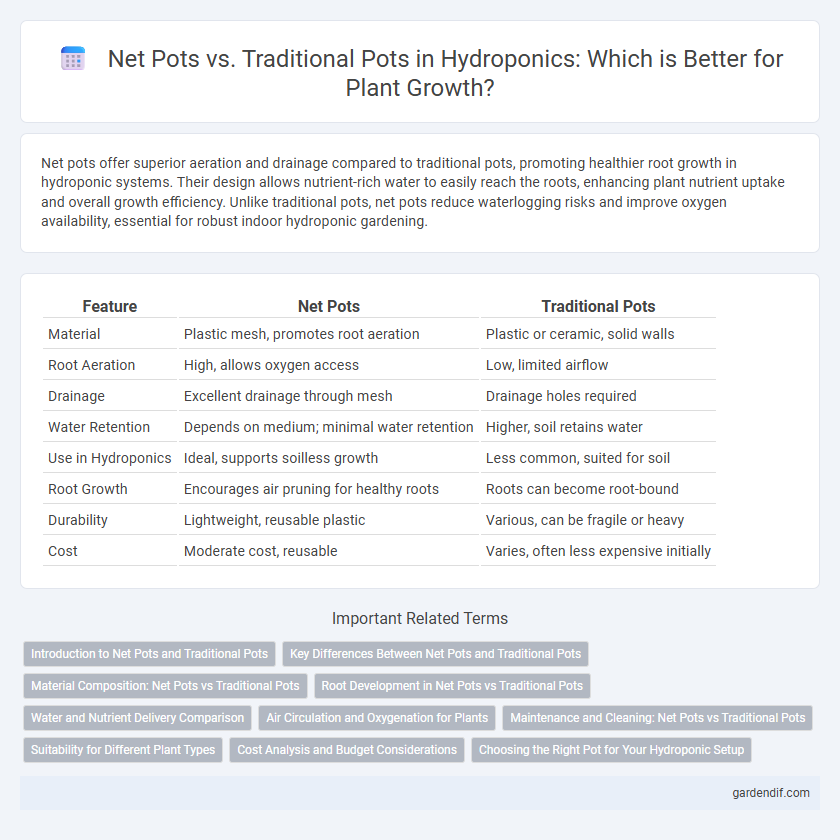
Net Pots vs Traditional Pots Illustration
Net pots offer superior aeration and drainage compared to traditional pots, promoting healthier root growth in hydroponic systems. Their design allows nutrient-rich water to easily reach the roots, enhancing plant nutrient uptake and overall growth efficiency. Unlike traditional pots, net pots reduce waterlogging risks and improve oxygen availability, essential for robust indoor hydroponic gardening.
Table of Comparison
| Feature | Net Pots | Traditional Pots |
|---|---|---|
| Material | Plastic mesh, promotes root aeration | Plastic or ceramic, solid walls |
| Root Aeration | High, allows oxygen access | Low, limited airflow |
| Drainage | Excellent drainage through mesh | Drainage holes required |
| Water Retention | Depends on medium; minimal water retention | Higher, soil retains water |
| Use in Hydroponics | Ideal, supports soilless growth | Less common, suited for soil |
| Root Growth | Encourages air pruning for healthy roots | Roots can become root-bound |
| Durability | Lightweight, reusable plastic | Various, can be fragile or heavy |
| Cost | Moderate cost, reusable | Varies, often less expensive initially |
Introduction to Net Pots and Traditional Pots
Net pots, commonly used in hydroponic systems, are designed with slotted sides and bottoms to allow roots to grow through and access nutrient-rich water directly. Traditional pots, typically made of solid plastic or clay, restrict root growth to the interior soil or medium, limiting oxygen and nutrient exposure. The open structure of net pots promotes better aeration and efficient nutrient uptake essential for hydroponic plant health and growth.
Key Differences Between Net Pots and Traditional Pots
Net pots allow better aeration and root growth due to their perforated design, promoting healthier plants in hydroponic systems. Traditional pots retain soil and moisture but limit airflow, which can lead to root rot and slower plant development. Hydroponic growers prefer net pots for efficient nutrient uptake and streamlined water circulation compared to traditional pots.
Material Composition: Net Pots vs Traditional Pots
Net pots are typically made from lightweight, durable plastic with multiple slits or holes, allowing optimal water and air circulation essential for hydroponic systems. Traditional pots are often composed of heavy materials like terracotta, ceramic, or plastic without drainage designs that support soil-based growth but limit aeration. The material composition of net pots enhances root aeration and nutrient absorption, while traditional pots retain soil moisture and provide structural stability for soil cultivation.
Root Development in Net Pots vs Traditional Pots
Net pots promote superior root aeration and oxygenation compared to traditional pots, enhancing root health and nutrient absorption in hydroponic systems. Their mesh design allows roots to grow through the openings, preventing root circling and enabling more extensive root development. Traditional pots often restrict root expansion, leading to compacted root systems and less efficient nutrient uptake.
Water and Nutrient Delivery Comparison
Net pots provide superior water and nutrient delivery by allowing roots to directly access the nutrient solution, promoting faster absorption and healthier growth. Traditional pots retain soil which can limit nutrient uptake and create uneven water distribution due to soil compaction. Hydroponic systems using net pots enhance oxygen circulation to roots, optimizing nutrient delivery efficiency compared to traditional soil pots.
Air Circulation and Oxygenation for Plants
Net pots provide superior air circulation and oxygenation compared to traditional pots due to their mesh design, which allows roots to access ample oxygen and promotes healthier root development. This increased oxygen flow helps prevent root rot and enhances nutrient uptake, crucial for hydroponic systems where oxygen availability is key. Traditional pots often restrict airflow, leading to denser root zones and reduced oxygen exposure, which can hinder plant growth and overall health.
Maintenance and Cleaning: Net Pots vs Traditional Pots
Net pots require less maintenance and are easier to clean due to their open structure, which allows water to flow freely and prevents soil buildup. Traditional pots often accumulate soil residues and require thorough scrubbing to remove contaminants and avoid disease. The reusable nature of net pots minimizes the risk of root rot and fungal growth, enhancing overall plant health in hydroponic systems.
Suitability for Different Plant Types
Net pots allow for superior aeration and root expansion, making them ideal for leafy greens, herbs, and plants with delicate root systems in hydroponic setups. Traditional pots, typically filled with soil or media, better support plants that require stable root anchorage and moisture retention, such as tomatoes, peppers, and larger fruiting plants. Selecting between net pots and traditional pots depends largely on plant species' root needs and the growing medium used in the hydroponic system.
Cost Analysis and Budget Considerations
Net pots typically cost more upfront than traditional pots but offer better water efficiency and reusable benefits that reduce long-term expenses in hydroponic systems. Traditional pots are generally cheaper initially but may lead to higher costs due to soil replacement, increased water use, and less durability. Evaluating budget constraints, net pots provide a cost-effective solution over time, especially for large-scale hydroponic farming, by minimizing maintenance and resource input.
Choosing the Right Pot for Your Hydroponic Setup
Net pots offer superior aeration and root access, promoting healthy plant growth in hydroponic systems compared to traditional solid pots. Their design facilitates optimal water and nutrient flow, preventing root rot and enhancing oxygen availability, crucial for hydroponic success. Selecting net pots with the appropriate size and mesh structure tailored to your plant type improves yield and system efficiency over conventional pots.
Net Pots vs Traditional Pots Infographic

 gardendif.com
gardendif.com